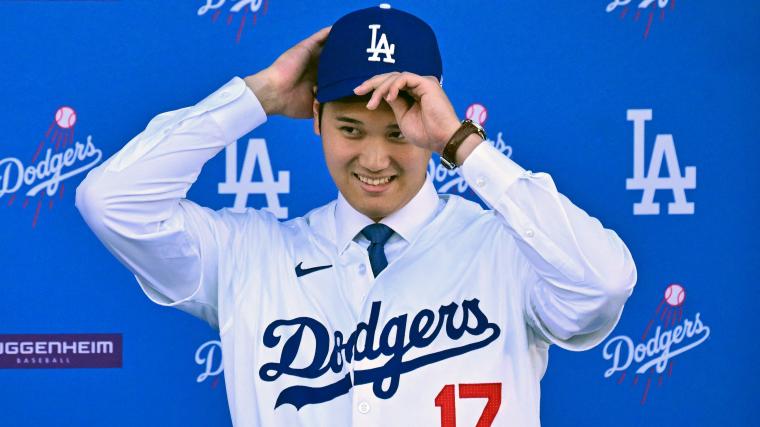Examining the Impact of Shohei Ohtani’s $700 Million Deferred Contract on Baseball Economics
The culmination of Shohei Ohtani’s free-agent signing with the Dodgers brought forth a roller coaster saga, marked by three particularly astonishing aspects. As we reflect on this transformative event, let’s delve into the third revelation that has sparked considerable intrigue: the staggering $700 million contract with an unprecedented deferral structure.

The Breakdown
Ohtani’s 10-year, $700 million contract deviates from the conventional yearly payment model. Instead of an annual $70 million, Ohtani receives a mere $2 million each year from the Dodgers. A groundbreaking 97% of his salary is deferred, without interest, with payments commencing on July 1, 2034, following the conclusion of his playing contract.
- $2 million per year from 2024-33 ($20 million total)
- $68 million per year from 2034-43 ($680 million total)
While deferred money in baseball contracts is not novel, Ohtani’s structure far surpasses previous instances, including those of Max Scherzer and Stephen Strasburg.
Legal and Financial Insight
To gain perspective on this groundbreaking deal, insights were sought from Michael Rueda, a partner and head of the U.S. Sports & Entertainment practice group at the international law firm Withers. Rueda, with a decade-plus experience in the sports and entertainment industries, noted Ohtani’s strategic foresight.
Rueda emphasized Ohtani’s holistic approach, balancing personal financial benefits with the goal of building a winning team. He highlighted the player’s ability to perceive the bigger picture and craft a deal that not only serves professional interests but also positions him favorably in the long term.
Interestingly, this deferral-heavy structure was not an exclusive offer to the Dodgers but a standardized proposal Ohtani presented to all potential teams. Farhan Zaidi, Giants president of baseball operations, confirmed the Giants’ acceptance of Ohtani’s terms, illustrating that other franchises recognized the merit of this innovative approach.
The Mechanics of Deferral
The intricate mechanics of Ohtani’s deferred contract are crucial to understanding its impact. The Dodgers, bound by rules, must fund the full cap hit ($46 million) within two years of it being earned. This translates to paying Ohtani $2 million annually in 2024 and 2025. From 2026 onward, they contribute $2 million annually while placing $44 million into an escrow account, repeating this process until the end of his playing contract in 2033. Subsequently, the deferred $68 million annually from 2034 onwards will be combined with the accumulated escrow amount.
Potential Industry Trends
While deferred money in contracts is not novel, Ohtani’s extreme deferral could influence future player-team negotiations. The question arises: will players consider deferring a portion of their salaries to enhance teams’ financial flexibility and bolster rosters, thus demonstrating a commitment to winning?
Veteran players, especially those who have already earned substantial sums, might contemplate deferrals as a way to contribute to team success. Justin Verlander serves as an example, having signed lucrative contracts without deferral. Ohtani’s precedent could prompt players and teams to explore more creative contractual structures.
The Broader Landscape
Considering the resources and motivations of certain teams, a trend of deferral-heavy deals could emerge. Teams with financial flexibility and a commitment to competitiveness, such as the Dodgers, Giants, New York clubs, Cubs, Phillies, Rangers, and Blue Jays, might embrace this innovative approach. Even mid-market clubs, recognizing the opportunity, could explore similar strategies.
Examining Dodgers’ Deferrals
In addition to Ohtani, the Dodgers have incorporated deferred money into contracts with Mookie Betts and Freddie Freeman. Although not at Ohtani’s scale, these deferrals represent a notable trend in the team’s approach to long-term contracts.
Ohtani’s Deferrals: $68 million per year starting July 1, 2034, through 2043.
Betts’ Deferrals: Commencing July 1, 2033, Betts receives $8 million annually in 2033-37, $10 million in 2038-39, and $11 million in 2040-44.
Freeman’s Deferrals: Beginning July 1, 2028, Freeman gets $4 million yearly from 2028-35 and $5 million annually from 2036-40.
The year-by-year breakdown reveals a total commitment of $852 million over 17 years, showcasing the substantial financial investment the Dodgers are making beyond the active playing period of these star players.
In summary, Shohei Ohtani’s innovative contract structure opens new possibilities in player-team negotiations and could influence the dynamics of future mega-deals in Major League Baseball. As the industry evolves, the impact of this groundbreaking contract will likely be felt across player compensation strategies and team financial management.
